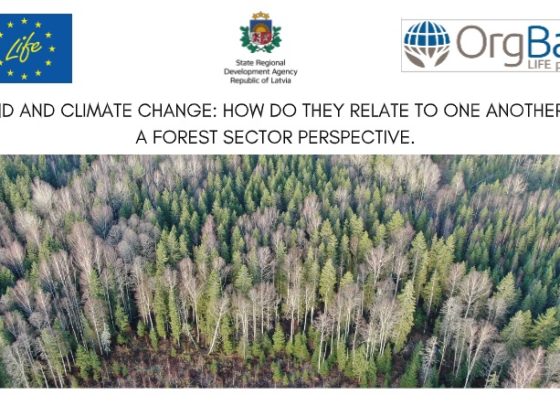Soils can turn into a net sink, but also into a net source of greenhouse gas emissions. In other words, in relation to climate change, they represent part of the problem, but also part of the solution. We addressed experts from all partner countries of the LIFE OrgBalt project to better understand this two-fold relationship, with a focus on the forest sector.
“Soil ecosystems can act as absorbers, reservoirs and emitters of greenhouse gas emissions”, said Dr. Olgirda Belova, member of the Department of Forest Protection and Game Management, Institute of Forestry LAMMC, partner in the LIFE OrgBalt project. Forest ecosystem in particular represent an important terrestrial stock of organic carbon and their management together with different uses of harvested wood, play a crucial role in the regulation of the concentration of atmospheric carbon dioxide[1].
Forests cover more than 40% of the terrestrial surface of the EU therefore they have an indisputable role in mitigating climate change[2].
We asked experts what do we mean by climate change mitigation measures and which are their potential. “By climate change mitigation measures”, explains us the research team of the Latvian State Forest Research Institute “Silava”, leading partner in the LIFE OrgBalt project, “we mean such organic soil management practices that could allow a decrease of greenhouse gas emissions from drained nutrient-rich organic soils managed for agriculture or forestry purposes. Scientific evidence in fact shows that luckily, we could significantly reduce greenhouse gas emissions just by changing the way in which organic soils are managed.
Focusing on nutrient-rich organic soils and forest management practices it’s of primary importance to understand the difficulties faced by the forestry sector, such as the damages caused by climate changes, the role played by sustainable management from a foresters’ perspective and forest mitigation potential.
Insects and diseases, and storms ad drought have been the main climate change related challenges faced by forests in the last years, according to many representatives of the forest sectors. In the representatives of the forest sectors opinion moreover there’s a lack of awareness at society level on the important role played by forest sustainable management. In addition, according to our interviewees, further research and closer interdisciplinary cooperation between scientists are needed. The need of data and tools for foresters to evaluate the potential economic return of their forest management has also been highlighted to promote the implementation of new innovating climate change mitigation measures.
LIFE OrgBalt Team
READ THE FULL ARTICLE TO FIND OUT MORE!
The article has been produced with the financial support of the LIFE Programme of the European Union and the State Regional Development Agency of Latvia within the Project “Demonstration of climate change mitigation potential of nutrients rich organic soils in Baltic States and Finland” (LIFE OrgBalt, LIFE18 CCM/LV/001158)
The developed article reflects only the LIFE
OrgBalt project beneficiaries’ view and the European Commission’s Executive
Agency for Small and Medium-sized Enterprises is not responsible for any use
that may be made of the information they contain.
[1] Statistics Explained (https://ec.europa.eu/eurostat/statisticsexplained/) – 04/12/2019, https://ec.europa.eu/eurostat/statistics-explained/index.php/Archive:Forestry_and_climate_change
[2] Statistics Explained (https://ec.europa.eu/eurostat/statisticsexplained/) – 04/12/2019, https://ec.europa.eu/eurostat/statistics-explained/index.php/Archive:Forestry_and_climate_change


